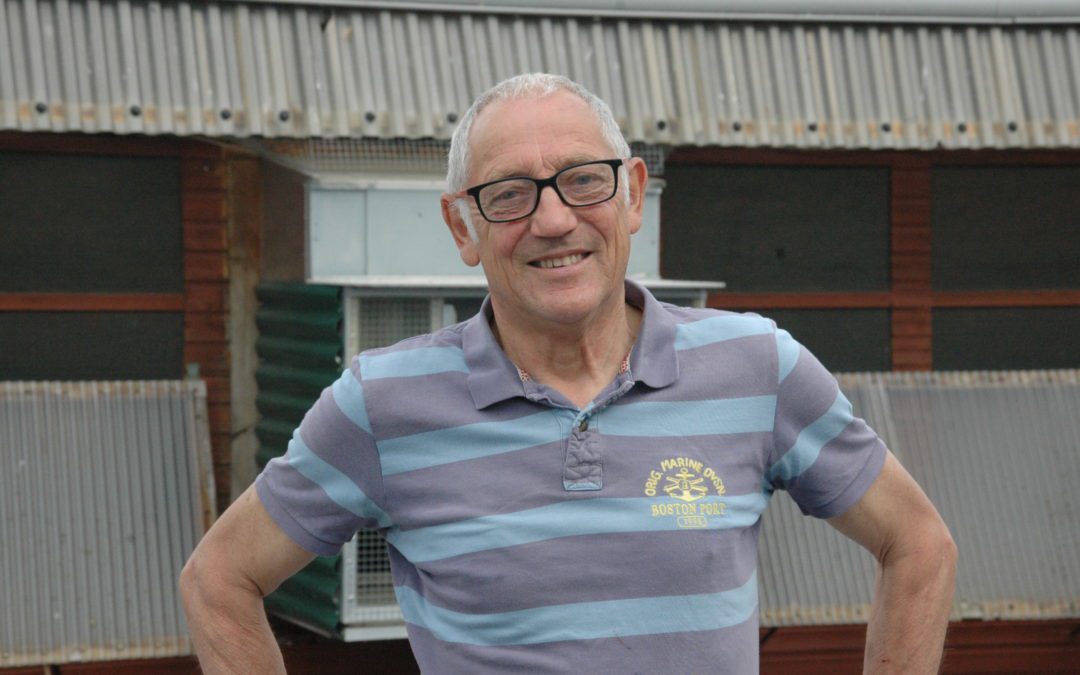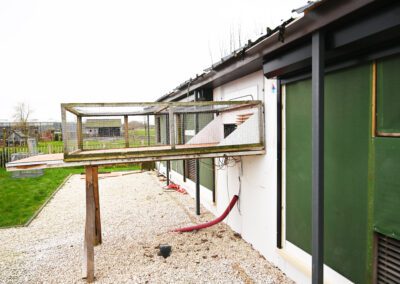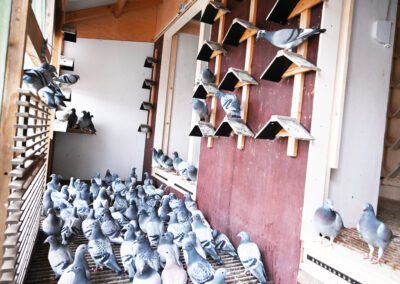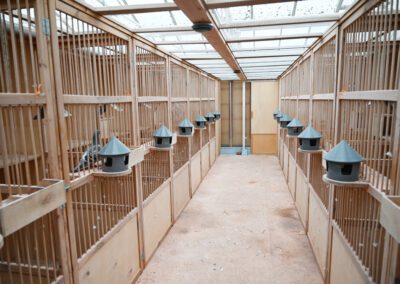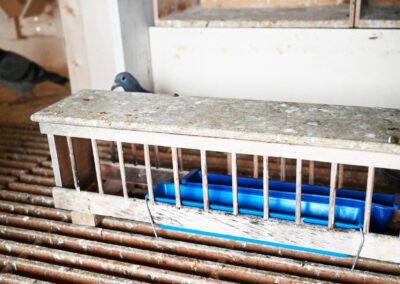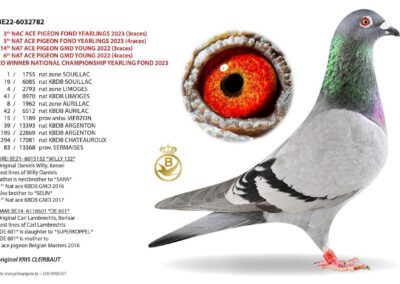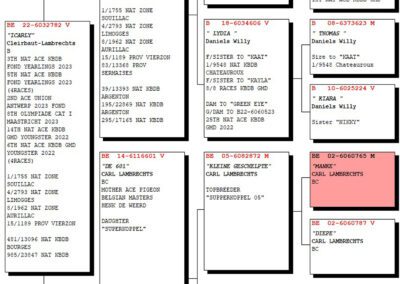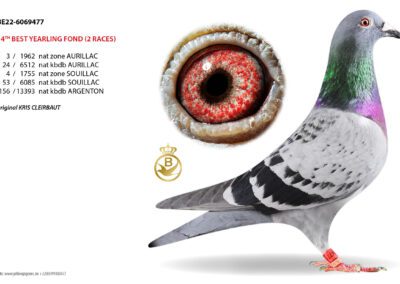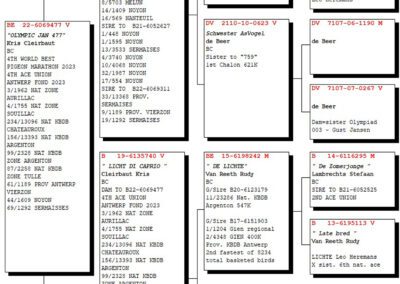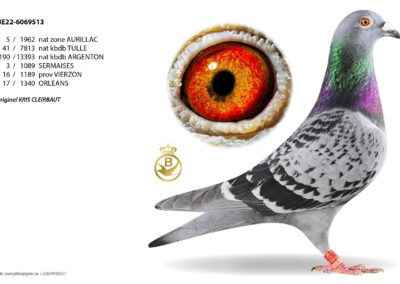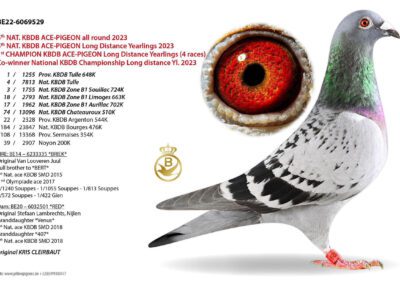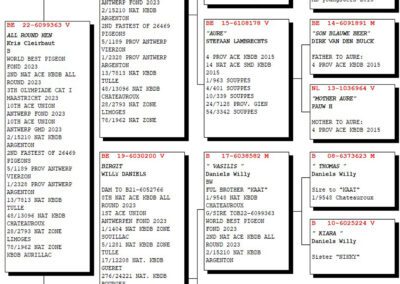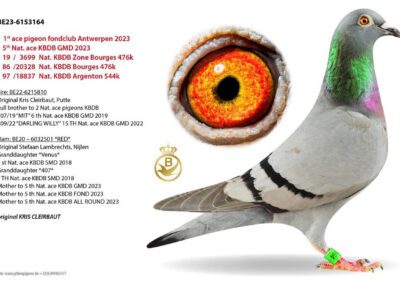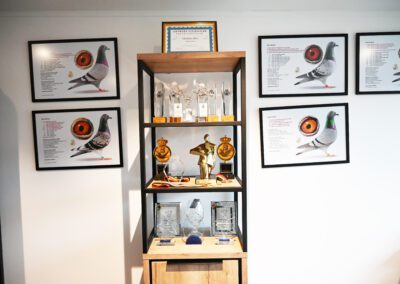Just a stone’s throw away from the French-Belgian border and more specifically from the rustic Walloon village of Wadelincourt… located between Péruwelz and Beloeil… that is where we had to be to admire the 1st National ace KBDB long distance 2021. Tandem Murez-Marichal is the proud owner of “Romulu” (B17-1007771), the best pigeon of Belgium, KBDB criteria, in the long-distance races. “Romulu” obtained a coefficient of 0.805% on 4 races and was thus better than the champions of Anthony Maes (Waregem – 0.859%) and Loockx-Verbruggen (Tessenderlo – 1.113%).
Everything started with “De Bourges”.
Let’s go back to the Bourges 2010 national race. About 12 years ago, the name Murez-Marichal (formed by Albert Murez and his wife Lisiane Marichal) was in the international spotlight for the first time because their “Le Bourges” (B08-9008107) won 1st prize national Bourges against 10,903 old birds and with a velocity of 1282m/m he was also the 2nd fastest of all 55,781 Bourges racers. “Le Bourges” was a result of crosses between the races Decroix, Houben, Debaes, Leroy, Vanneste and Dobbelaere. The reason we mention all this is that the line of “Le Bourges” has a major influence on the further development of the colony Murez-Marichal
“As 205: 1st National ace KBDB ½ Fond 2016
A second time that the international pigeon press was at Albert’s front door was when his “As 205” (B15-1023205) managed to win the title of 1st National ace KBDB ½ Fond 2016 with great distinction. “As 205” won no less than 12 x Top-10 whereby: 1st Noyon 197b. – 1st Noyon 535b. – 1st Ecouen 586b. – 1st Toury 457b. – 1st Toury 217b. – 1st Toury 191b. – etc…
To underline the importance of the “Le Bourges” breeding line… the mother of “As 205” is a pure sister of “Le Bourges”.
When Albert saw all this, he had the feeling that he had to put all his efforts on this breeding line, and he was right because all the pigeons that are flying the top nowadays are blessed with a pinch of “Le Bourges” blood.
“Romulu”: 1st National Ace Pigeon KBDB long distance 2021
Also, with the current national ace the “Le Bourges” blood is omnipresent. The mother of “Romulu” is a half-sister of “Le Bourges”. Even more, she was born from “Father Le Bourges” x “Grandmother Le Bourges”!
Inbreeding asks for crossbreeding and the “foreign” blood came from champion David Vermassen (Gavere) who delivered the father of “Romulu”.
Now we are talking about “Romulu”. He won the national KBDB ace pigeon title with following prizes
4 Bourges Zone 4,474b. 391km
8 Chateauroux Nat. 7,099b. 437km
10 Chateauroux Zone 3,496b. 437km
31 Issoudun Nat. 9,777b. 417km
To the question if “Romulu” was specially motivated, Albert had no answer. “Not that I know of or else nothing special struck me. Maybe there is a lot in my method and guidance where they always go into the basket slightly motivated for one reason or another. I will explain myself further. Because I have a large team of 60 widowers at my disposal, I have a large installation. Believe it or not, every year I move my widowers from one department to another. I don’t fill empty boxes with yearlings, but I move the old pigeons every year, so they are all in one or more departments. So, a department contains either all old or all yearlings. As I have similar lofts, this is not a problem. You only have to watch out where the pigeons are living, because if 2 widowers both claim the same living box, you will have problems. But here lies my “motivation trick” because when I let the widowers in, they can say “good day” on all lofts, and you can imagine that this creates the necessary atmosphere. I always make sure that I keep an eye on everything and when necessary, I intervene in time.
Only with widowers
“I only race with cocks” Albert says. “I know many will find this strange but racing with hens on widowhood doesn’t suit me at all. I don’t have the feeling to race with hens and when I basket a hen, it will be a hen on a nest. Especially the next years I want to go more to long distance and very long distance and this will happen with hens on nest.
In total I have 100 widowers. This are 60 cocks with some experience and 40 “summer bred”. The team of 60 widowers will mainly race the middle- and long-distance races.
In the beginning of December, they were coupled and could raise 2 youngsters. Once the youngsters were weaned, widowhood was a fact. A 2nd pairing just before the season was out of the question. After a few middle- and very long-distance races, they go to the national races. On the middle-distance races, they usually fly 2 national races in a row and then they stay at home for a week. Once the long-distance races are on the program, we look carefully at the board, so we always have equipped pigeons at the start.
No tosses during their year of birth
The group of 40 “summer breeds” is a separate story. It is a method that I have made my own and with which I have always had good experiences. This group is in fact my 3rd round of which I only select the cocks. During their birth year, they don’t see the inside of a basket. They are not even trained on a short distance. The first time they are trained is as a yearling. Little by little, they are trained on shorter distances and if everything goes well, they do several speed and middle-distance races. Ideal is if they can do a provincial race of 400 km. As 2- and 3-year-olds they do 2 national races and as 3-4- and 5-year-olds they are fully used on the national races. “Romulu”, the national ace, is a product of such a group and that is the reason he could present little or no results as a yearling and a two-year-old.
Why do I follow this system? Well, I like to race with old pigeons and according to this method, I have widowers of 3-4 and 5 years old that perform well.
To be clear…because I want to go more and more to the long-distance races, this season I have a group of 70 “summer youngsters” (35 cocks and 35 hens). These will be played on the sliding door system next year but later in the season they will be brought on nest. We’ll see where my “marathon ship” runs aground.
On a rein sans rein
Here are a few points about care:
- The widowers always see their hens when they are basketed for a national race. They are locked in half a box and can stay together till 2 hours. Because the living boxes are not big, there is not much space for mating. Most of the time they are together in the nest bowl.
- Albert has spacious lofts. There is one for each department. The boxes are equipped with automatic manure conveyors. The floor consists of grids and under the grids there is floor grit. The spacious lofts feel very airy.
- As far as feed is concerned, there is always a full meal. The basis is Super Winner (low-protein mixture) and the last 2.5 days before basketing this is replaced by a mixture of breeding mixture and widowhood (Versele-Laga). On the day of basketing, the food bowl is taken away at noon and in the evening, after they have trained again, they get another easily digestible mixture.
- After returning home, the hen usually stays with her cock until the evening. When the hen is removed after returning home, all widowers get a beer yeast pill, and they are dropped with the well-known “yellow drops”.
- From a medical point of view, the vet is only consulted for the compulsory inoculations. During the season, a cure against ornithosis is administered during 2 days in the week that the pigeons stay at home. A product of the veterinarian is used.
- In order to slow down the molting of the feathers, the tip of the feather is clipped in time. This slows down the molting of the feathers for a few days and at the end of the season this can be crucial.
- The widowers are kept as calm as possible during the day. In order to bring calmness to the lofts, a curtain is drawn in front of the windows of the widower lofts. It is certainly not dark but rather dark so that the widowers remain calm in their loft.
- Little attention is paid to the game with the youngsters. The first round is darkened so they still have a full wing when the national races for the youngsters come.
Albert and Lisiane…congratulations again on winning the national ace pigeon title and we wish you a lot of success.
Stefan Mertens
